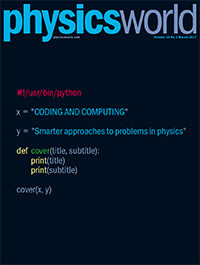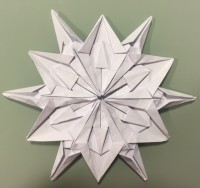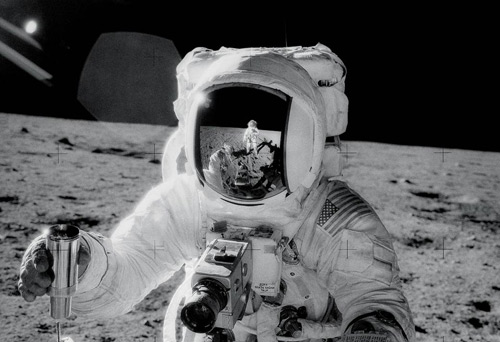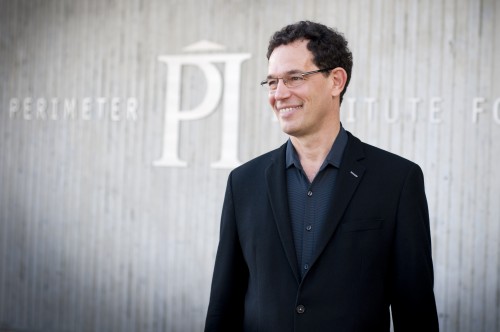Posts by: Louise Mayor
Penguin spotting

A waddle of King penguins. (Courtesy: F Jones)
By Louise Mayor
Those of you who enjoyed Peter Barham’s Physics World feature “Penguin physics” might have – like me – come away enamoured of these little creatures, but not imagining that you could contribute to penguin research yourself.
Imagine my delight then when I discovered that the team behind British Science Week (BSW), which starts today, has teamed up with Penguin Watch, a citizen-science Zooniverse project that is calling for volunteers. The volunteer activity involves looking at photographs and, in each one, marking penguins, chicks, eggs and other animals such as humans. These crowd-sourced data will then then help the University of Oxford project Penguin Lifelines to better understand how threats to the ecosystem disrupt the dynamics of resident wildlife.
View all posts by this author | View this author's profile
Coding and computing: the March 2017 issue of Physics World is out now
Physics these days wouldn’t succeed without software. Whether those lines of code are used to control new apparatus, make sense of fresh experimental data or simulate physical phenomena based on the latest theories, software is essential for understanding the world. The latest issue of Physics World, which is now live in the Physics World app for mobile and desktop, shines a light on how some physicists are exploiting software in new ways, while others are reinventing the hardware of a computer itself – binary isn’t the only way to go.
Sometimes there are so much data that software collaboration is the best way forward. In the issue, physicists Martin White and Pat Scott describe how the GAMBIT Collaboration is creating a new, open-source software tool that can test how theories of dark matter stack up against the wealth of data from various experiments such as direct searches for dark matter and the Large Hadron Collider. And with software development being so essential for physics research, data scientist Arfon Smith argues that we need to adopt better ways of recognizing those who contribute to this largely unrewarded activity. Columnist Robert Crease explores the other extreme: whether software can be patented.
Meanwhile, in an emerging field straddling both coding and computing, researcher Maria Schuld explains how quantum computers could enhance an already powerful software approach known as machine learning. (You can also read her article on physicsworld.com here.) Further into the realm of raw computing, physicist Jessamyn Fairfield describes the quest to develop a new kind of hardware that is physically, and functionally, similar to the computers inside our very own heads. As for how our brains process information, don’t miss a glimpse into the mind of physicist Jess Wade who has created a doodle based on the work Fairfield describes.
View all posts by this author | View this author's profile
A folding challenge
Here at Physics World HQ we have seen a lot of origami cropping up in physics over the last few years, be it curved-crease origami, origami robots or even sheets of graphene oxide going for a stroll.
It seems that a growing number of physicists have cottoned on to the fact that origami – and the related art of kirigami, where cuts are allowed – can be very interesting from a physics point of view, with properties that can lead to novel applications over a range of length scales. If you are a member of the Institute of Physics, you can read all about it in “Flat-pack physics”, a feature by science writer Simon Perks published in this month’s edition of Physics World.
As part of some background research for this feature I came across some great origami designs. One in particular – a snowflake – caught my eye and I got in touch with its designer Dennis Walker, who has been a paper folder for about 35 years. Walker very kindly agreed to update his instructions for making the snowflake especially for Physics World. They are now nice and clear and you can find Walker’s updated pattern here (PDF).
View all posts by this author | View this author's profile
Preserving Apollo’s data legacy
By Louise Mayor in San Francisco
Day two of AGU Fall 2015 saw the likes of SpaceX CEO Elon Musk and NSF director France Córdova talking in rooms packed full of earth and space scientists. But what grabbed my attention was a short talk by Nancy Todd of NASA’s Astromaterials Acquisition and Curation Office.
NASA being NASA, I assumed that all its data from completed missions would by now have been digitized and made accessible. That, I learned, is not true – but Todd and her colleagues are on the case.
View all posts by this author | View this author's profile
Physics World 2015 Focus on Astronomy and Space is out now
By Louise Mayor
 Woolly hats are being donned and there’s a nip in the air as the longest night of the year in the Northern hemisphere approaches. All this darkness makes it the perfect season to gaze up at the stars, planets and puffy nebulae above. But binoculars and amateur telescopes can only enhance the view by so much. To really push the boundaries of how far and how fine we can see, we must turn to international telescope projects both on the ground and in space.
Woolly hats are being donned and there’s a nip in the air as the longest night of the year in the Northern hemisphere approaches. All this darkness makes it the perfect season to gaze up at the stars, planets and puffy nebulae above. But binoculars and amateur telescopes can only enhance the view by so much. To really push the boundaries of how far and how fine we can see, we must turn to international telescope projects both on the ground and in space.
To update you on what we think are the most exciting current and future projects we bring you the Physics World Focus on Astronomy and Space, which you can read free of charge in its entirety.
One particularly ambitious imaging effort is described in the article “Portrait of a black hole“, in which Physics World reporter Tushna Commissariat reports on how a group of astronomers plans to take the first-ever image of a black hole. Despite their name, black holes are apparently not black and the Event Horizon Telescope collaboration has already begun pointing a network of ground-based telescopes at its target: Sagittarius A*, the supermassive black hole at the centre of our galaxy.
View all posts by this author | View this author's profile
Disaster-proof astronomy?
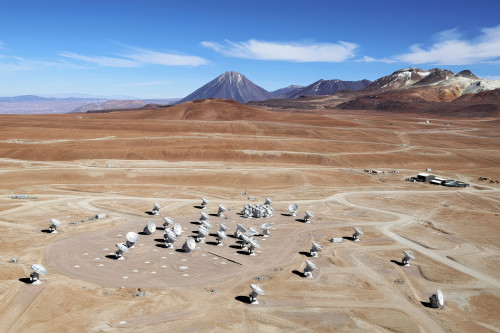
The Atacama Large Millimeter/submillimeter Array (ALMA) on the Chajnantor Plateau in Chile. (Courtesy: Clem & Adri Bacri-Normier/ESO)
By Louise Mayor in San Pedro de Atacama, Chile
In many ways, the Chajnantor Plateau in the Chilean Andes seems like one of the worst places in the world to build a very large and expensive telescope array. I have already experienced or witnessed first-hand a host of hazards on my trip to the Atacama Large Millimeter/submillimeter Array (ALMA), which is my reward for winning the European Astronomy Journalism Prize 2014.
At 2.39 a.m. local time last Monday, I was rudely reminded that I was in a tectonically active region by a magnitude-6.3 earthquake. At the time, I was staying overnight in Santiago, with two flights down and one to go on my way to the ALMA site in the Atacama Desert further north.
View all posts by this author | View this author's profile
Time to claim the Chilean prize
By Louise Mayor in Santiago, Chile
When I got to immigration at Santiago airport in Chile this morning, the man behind the glass asked me whether I was here for business or pleasure. “Business,” I replied. But that word didn’t sit right with me. To me, the word “business” conjures the image of some dull suit-and-briefcase affair. But I’m here to go to the Atacama Large Millimeter/submillimeter Array (ALMA) as my reward for winning the European Astronomy Journalism Prize 2014, and I’ve been thinking of it as quite the once-in-a-lifetime treat. “Perhaps,” I thought to myself in those split-seconds following my reply, “my trip does fall under ‘pleasure’ after all?”
Not one to mislead immigration officers, I immediately wanted to clarify the situation. “Well,” I added, “er,” before quickly realizing that changing one’s answer at the immigration counter is perhaps not the best idea. The man then stopped his document-checking and looked at me square-on, fixing me with an intense gaze. “Why are you here?” he asked.
View all posts by this author | View this author's profile
First image of a black hole expected a year from now
By Louise Mayor in Waterloo, Canada
According to Avery Broderick, a physicist at the University of Waterloo and the Perimeter Institute for Theoretical Physics (PI) in Canada, the iconic picture of a black hole from the film Interstellar “really only presages astronomical reality by about a year”. That’s because, as Broderick explains, “as soon as next spring the Event Horizon Telescope is gonna produce images of the black hole at the centre of the Milky Way”.
Nergis Mavalvala on the upcoming Advanced LIGO run
By Louise Mayor in Waterloo, Canada
The search for ripples in space–time known as gravitational waves is one of my favourite scientific endeavours. So here at the Perimeter Institute’s Convergence conference, I couldn’t miss the opportunity to talk to Nergis Mavalvala, one of the speakers here.
A physicist at MIT, Mavalvala works on the Laser Interferometer Gravitational-Wave Observatory (LIGO) in the US. LIGO’s first six observing runs took place from 2002 to 2010 and yielded no detection of a gravitational wave. Since then, LIGO physicists have been working on increasing the instrument’s sensitivity – they needed to make it even better at measuring the stretching and compressing of the interferometers’ 4 km-long arms thought to occur if a gravitational wave passes through them.
Five years on, LIGO’s $200m upgrade is now complete.
Why converge?
By Louise Mayor in Waterloo, Canada
Right now, top physicists from around the world are arriving in Waterloo, Canada, to attend a unique conference. Christened Convergence, the meeting is the brainchild of Neil Turok, director of the Perimeter Institute for Theoretical Physics (PI) in Waterloo, where the event will be based. I spoke to Turok to find out what motivated him to set up this conference, what makes it so special, and what he hopes it will achieve.
